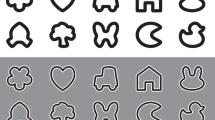Abstract
Purpose
The aim of this study was to compare three different methods to measure visual acuity (VA) in healthy and amblyopic preschool children: a Snellen E chart (SE), a single Lea symbols (SLS), and a crowded Lea symbols (CLS).
Methods
Seventy-eight eyes of 54 patients (28 females, 26 males) were included in this cross-sectional, comparative study. The control group consisted of 30 healthy cases, and the amblyopic group consisted of 24 patients with amblyopia. Best-corrected VA (BCVA) measurements with SLS, CLS, and SE were compared in control eyes (CE), amblyopic eyes (AE), and fellow eyes (FE) separately.
Results
The mean age of the cohort was 5.7 ± 0.7 years (range 5–7 years). The mean refractive error was +1.02 ± 0.36 D (diopter, spherical equivalent) in CE, +5.59 ± 2.45 D in AE, and +3.96 ± 2.38 D in FE. The median BCVA (logMAR) was (in order of SLS, CLS, and SE) 0.00 [interquartile range (IQR) 0.10], 0.10 (IQR 0.10), 0.00 (IQR 0.10) in CE, 0.25 (IQR 0.33), 0.35 (IQR 0.30), 0.25 (IQR 0.38) in AE, and 0.10 (IQR 0.08), 0.10 (IQR 0.00), 0.10 (IQR 0.10) in FE. There was no statistically significant difference between the three methods in terms of the CE or FE (p > 0.05). In contrast, there was a statistically significant difference in AE (p < 0.05). The mean VA measurement with SLS was higher compared with CLS in AE. A positive and strong correlation between the three charts was found in all of the groups (p < 0.001).
Conclusion
We found SLS, CLS, and SE to be consistent: all three methods can be used to obtain measurements of VA in healthy and amblyopic preschool children.





Similar content being viewed by others
References
Becker R, Hübsch S, Graf MH, Kaufmann H (2002) Examination of young children with Lea symbols. Br J Ophthalmol 86:513–516
Sanker N, Dhirani S, Bhakat P (2013) Comparison of visual acuity results in preschool children with Lea symbols and Bailey–Lovie E chart. Middle East Afr J Ophthalmol 20:345–348
Mocan MC, Covarrubias MN, Wright KW (2005) Comparison of visual acuity levels in pediatric patients with amblyopia using Wright figures, Allen optotypes, and Snellen letters. JAAPOS 9:48–52
Committee on Practise and Ambulatory Medicine (1996) Section on ophthalmology. Eye examination and vision screening in infants, children, and young adults. Pediatrics 98:153–157
Candy TR, Mihoulam SR, Nosofsky RM, Dobson V (2011) Adult discrimination performance for pediatric acuity test optotypes. Invest Ophthalmol Vis Sci 52:4307–4313
Repka MX (2002) Use of Lea symbols in young children. Br J Ophthalmol 86:489–490
Wesemann W, Schiefer U, Bach M (2010) New DIN norms for determination of visual acuity. Ophthalmologe 107:821–826
Gregori NZ, Feuer W, Rosenfeld PJ (2010) Novel method for analyzing Snellen visual acuity measurements. Retina 30:1046–1050
Faul F, Erdfelder E, Buchner A, Lang AG (2009) Statistical power analyses using G*Power 3.1: tests for correlation and regression analyses. Behav Res Methods 41:1149–1160
Cyert L, Schmidt P, Maguire M, Moore B, Dobson V, Quinn G, Vision in Preschoolers (VIP) Study Group (2003) Threshold visual acuity testing of preschool children using the crowded HOTV and Lea symbols acuity tests. J AAPOS 7:396–399
Gräf M, Becker R, Kaufmann H (2000) Lea symbols: visual acuity assessment and detection of amblyopia. Graefes Arch Clin Exp Ophthalmol 238:53–58
Lorenz B, Brodsky MC (2010) Pediatric ophthalmology, neuroophthalmology, genetics, 1st edn. Springer, Heidelberg
Dobson V, Clifford-Donaldson CE, Miller JM, Garvey KA, Harvey EM (2009) A comparison of Lea symbols versus ETDRS letter distance visual acuity in a population of young children with a high prevalence of astigmatism. J AAPOS 13:253–257
Ferris FL, Kassoff A, Bresnick GH, Bailey I (1982) New visual acuity charts for clinical research. Am J Ophthalmol 94:91–96
Committee on Vision (1980) Recommended standard procedures for the clinical measurement and specification of visual acuity. Adv Ophthalmol 41:103–148
Liu L, Wang K, Liao B, Xu L, Han S (2004) Perceptual salience of global structures and the crowding effect in amblyopia. Graefes Arch Clin Exp Ophthalmol 242:566–570
Lalor SJ, Formankiewicz MA, Waugh SJ (2016) Crowding and visual acuity in adults using paediatric test letters, pictures and symbols. Vision Res 121:31–38
Author information
Authors and Affiliations
Corresponding author
Ethics declarations
Conflict of interest
Aslı İnal, Osman Bulut Ocak, Ebru Demet Aygıt, Ihsan Yılmaz, Berkay İnal, Muhittin Taşkapılı, and Birsen Gökyiğit declares that they have no conflict of interest.
Ethical approval
The study protocol followed the principles in the Declaration of Helsinki.
Informed consent
Informed consent was obtained from all individual participants included in the study.
Rights and permissions
About this article
Cite this article
Inal, A., Ocak, O.B., Aygit, E.D. et al. Comparison of visual acuity measurements via three different methods in preschool children: Lea symbols, crowded Lea symbols, Snellen E chart. Int Ophthalmol 38, 1385–1391 (2018). https://doi.org/10.1007/s10792-017-0596-1
Received:
Accepted:
Published:
Issue Date:
DOI: https://doi.org/10.1007/s10792-017-0596-1




